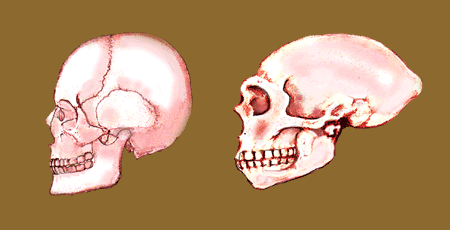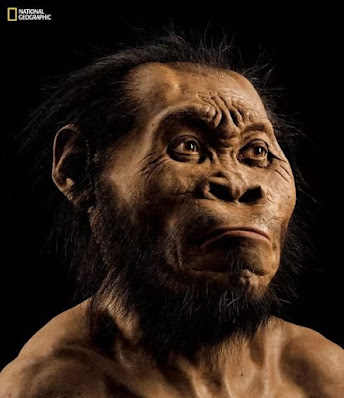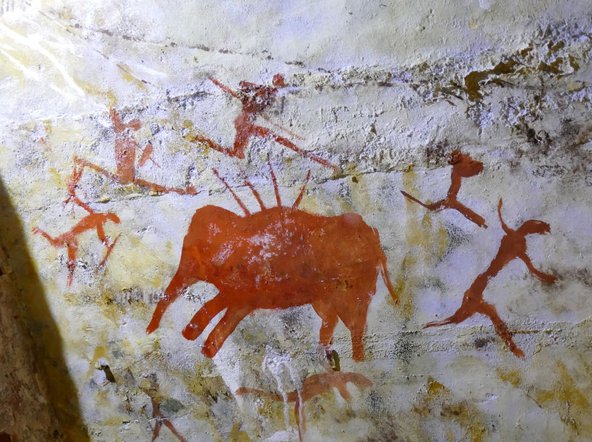Skull and face changes define modern humans
Skull and face changes define modern humans – Harvard Gazette
Evidence shows our brains and faces have gotten smaller
February 28, 2002
Daniel Lieberman can see millions of years of human evolution at a glance. The collection of skulls on his office shelves come from chimpanzees, long-extinct humans, and modern men and women. The hollow eye sockets, ancient teeth, and empty skulls pose the same question every day: What made us different from our archaic ancestors?
So far Lieberman has found some good answers and has come up with some controversial ideas. “It has long been thought that our skulls are extremely different from those of our ancient ancestors,” says the Harvard professor of biological anthropology. “But it turns out that you don’t need to change many things to go from one skull type to the other. Just a handful of changes could shift the oblong, football shape of a Neandertal cranium to the rounded, soccer ball shape we see all around us today. Those changes would also move the face under the brain case, retracting the protruding face of our ancient ancestors and decreasing the size of their prominent brow ridge.” These early alterations were followed by a steady decrease in human face and body size, which has been occurring over the past 10,000 years or so. As the severe climate of the ice ages ended, the bodies and faces of most large animals have gotten smaller. In humans, chewing softer, processed food also has contributed to reducing face size by decreasing the largeness of our jaws and jaw muscles. “Our faces are not only smaller than those of the first modern humans but also smaller than those of our ancestors’ who lived only 300 years ago,” Lieberman points out.
Modern humans differ from archaic humans in many respects, but anthropologists have been trying to define our species, Homo sapiens, based on the features of their skulls alone. That’s because skulls vary in obvious ways and many have survived as fossils. “The problem is that some skulls that are clearly modern don’t have all the modern features and a number of clearly archaic skulls have some of these features,” Lieberman notes.
He and his colleagues focus on crania, the skull minus the jaw. “We don’t look at differences in pelvises or jaws, for example, but what we have come up with is a simple pattern that is unique to modern humans.”
Eam : As the last ice age (about 110,000 years ago to about 10,000 years ago) ended and the earth's temperature rose, the human body became smaller, which could mean that there was no need to accumulate a lot of fat in the body. About 10,000 years ago is said to be the point at which agriculture began.
Regarding the capacity of the brain, it seems necessary to first explain the rapid increase in capacity about 2 million years ago.
The following is a summary of the knowledge I learned while exploring the 'history of body posture change'.
Mutagenic extinction of tail due to 'long arms of monkey replace function of tail (about 25 million years ago, Apes) --> Knuckle walking in gorillas (about 8 million years ago) --> Beginning of bipedal walking (about 6 million years ago) -- > Mainly bipedal walking (about 4 million years ago) --> Use of tools (about 2.5 million years ago) --> Fully bipedal walking (about 2 million years ago) & Rapid increase in brain capacity --> Use of fire (about 140 million years ago) --> Use of spears for hunting (about 500,000 years ago) --> Bipedal walking with zero head moment (about 400,000 years ago to about 400,000 years ago) --> Appearance of Homo sapiens (about 200,000 years ago) --> Beginning of clothing (about 120,000 years ago) --> Use of language (about 100,000 to about 50,000 years ago) --> Migrating out of Africa (about 45,000 years ago) --> D4 mutation occurrence (about 40,000 years ago) --> Beginning of agriculture (about 10,000 years ago) --> Use of letters (about 7,000 years ago) - -> Emergence of civilization (about 6,000 years ago) --> Emergence of law (about 5,000 years ago) --> Generalization of agriculture (about 3,000 years ago) & Bipedal walking with protruded head moment & Beginning of brain capacity decrease --> Invention of the automobile (about 250 years ago) --> Invention of the Internet (about 70 years ago) & Rapid sedentary activity-oriented socialization & intensification of slouching
I think that the reason for the sudden increase in brain capacity about 2 million years ago is that surplus energy caused an increase in brain activity. This surplus energy was created as the energy that muscles had to use to support the head moment caused by the head protruding forward was almost eliminated as 'complete Upright' became possible.
Agriculture appears to have begun at the end of the last Ice Age. However, this Agriculturing serves to change the central activity of daily life from running to walking or sitting. This change in daily posture from running with the body wide open to walking or sitting in a slouched posture means that the moment induced by the head increased again. The increase in this head-induced moment appears to cause a gradual decrease in brain capacity.
IN YOUR FACE
Lieberman, graduate student Brandeis McBratney, and postdoctoral fellow Gail Krovitz took CAT scans of 119 human skulls, ranging from modern men and women to those hundreds of thousands of years old. The scans provided three-dimensional images of the sites of skull growth, joints where individual bony plates that make up the skull come together. Their analysis, published last month in the Proceedings of the National Academy of Sciences, showed only a few differences between modern skulls, and those of Neandertals and earlier human ancestors. The major change appears in the cranial base, the plate of bone that forms both the roof of our faces and the floor of our brain case. Lieberman shows its location by poking his finger through an empty eye socket and touching the bottom of that bony platform. According to him, a sharper downward bend in the platform at a position near the temples makes modern skulls rounder than those of Neandertals and more ancient species. The flexion, which coincided with a forward extension of the cranial base, also moved faces under the front part of the brain and eliminated heavy brow ridges.
Eam : I hypothesized that the following three reasons had an effect on why the skull changed from an American football ball shape to a soccer ball shape. First, the 'evolution of the species toward a completely upright direction' leads to a 'decrease in the moment induced by the forward protrusion of the head', and this decrease leads to 'the decrease of the control range of the inertial force required to the head during activity'. This control range decrease led to the decrease of the need for the chin to protrude forward. This reduced need has led to a change to a skull that resembles a soccer ball. In detail, I notice changes in the shape and angle of the anterior part, where the eyes and nose are located, rather than the shape of the back of the skull.
Evolution to a completely upright direction --> Decrease of the moment induced by the forward protruded head --> The decrease of the control range of the inertial force required to the head --> The decrease of the need for the chin to be protruded --> A skull that more closely resembles a soccer ball
The shorter the horizontal distance between the head and the load-bearing point (forelimbs in tetrapods, feet in humans), the less the head's ability to adjust the inertial forces required for running activities. This means that the greater the horizontal distance above, the more the chin needs to protrude forward in order to secure the stability of the activity. There is a trend in the shape of the skull in all species, from reptiles to humans. The closer their posture is to upright, the more spherical the skull is, and the farther from upright, the more streamlined it is, like an American football ball.
 The eyelid bulge, which was necessary to prevent rainwater from entering the eyes, nose and mouth, is no longer necessary due to the retraction of the chin. The flow direction of air through the nose needed to be maintained in an oblique direction for smooth breathing and prevention of the inflow of foreign substances, so the nose had to rise in humans with retracted jaws. This seems to be the reason why Europeans have taller noses than Asians.
The eyelid bulge, which was necessary to prevent rainwater from entering the eyes, nose and mouth, is no longer necessary due to the retraction of the chin. The flow direction of air through the nose needed to be maintained in an oblique direction for smooth breathing and prevention of the inflow of foreign substances, so the nose had to rise in humans with retracted jaws. This seems to be the reason why Europeans have taller noses than Asians.
Second, 'increased intelligence' and reduced need for 'fast movement speed for hunting or escaping' reduced the need for a streamlined skull, leading to evolution closer to a soccer ball shape. The closer it is to the streamlined shape, the less energy loss due to air resistance during movement.
Third, mankind's ability to use tools reduced the need for teeth as a means of attack. For species other than humans, teeth serve as tools for attack and crushing food, but as humans use tools, the need to use teeth as a means of attack for hunting or defense against enemy attacks has decreased. The reduced need for teeth as a means of attack led to a reduced need for the jaws to protrude forward.
GETTING A HEAD
What caused these changes? No one has any samples of ancient brains to know for sure, but Lieberman and his colleagues believe that the alterations follow from an expansion of the temporal lobes of the brain, the areas that sit between the temples. “We think that an expansion of the soft brain tissue changes the shape of the hard skull bones, not the other way around,” notes McBratney. “The skull just goes along for the ride.” The temporal lobes sit right where the cranial base of modern humans bends downward, so it makes sense to think that a growing brain is responsible for this and other shifts in the brain case. Lieberman’s work suggests that modern humans have more voluminous temporal cavities than do their ancient ancestors. Besides containing a poker chip-size area responsible for hearing, these lobes handle functions related to memory and perception. In front of the temporal lobes, behind the forehead, lie the frontal lobes, areas associated with organization, planning, decision making, and other behaviors allied with cognition and creativity. But frontal lobes have not gained much relative size in the millions of years of human evolution. “Your frontal lobes and those of chimpanzees are about the same size relative to the rest of the brain,” Lieberman notes. How come? The answer is very complex. However, among other things, it involves changes in brain cells themselves, that is, in the development of more complex neural circuits and in the formation of new connections with other parts of the brain, such as the frontal lobes. Neandertals had larger brains than we now do. But modern humans roaming around Africa and Europe 90,000 years ago had brains about the same size as Neandertals, albeit with larger temporal lobes. As mentioned previously, human brains and bodies have been getting smaller since the last ice age ended. However, Lieberman notes, the decrease in our brain size is relatively smaller than that of our faces. The latter still goes on.
Eam : It is known that the frontal lobe controls the function of moving, thinking and speaking, and the temporal lobe controls the function of memory, partially speaking, and listening and understanding. The change from a hunter-gatherer society to an agricultural society seems to have required more functions of the temporal lobe.
CULTURAL “BIG BANG”
Anthropological, biological, and genetic evidence all put the origin of modern humans at between 200,000 and 100,000 years ago, probably in Africa. There is also much data that show an outburst of cultural behavior occurring around 50,000-40,000 years ago in Europe. That’s when archaeologists date the oldest evidence of burial ceremonies, body ornaments, and cave paintings. What was going on during the 100,000 years or so between the anatomical and cultural revolutions? Lieberman doubts that such a great gap exists. “When archaeologists find the first evidence for something, that doesn’t mean that’s when it first occurred,” he says. Lately, new examples of human craft and culture, found in Africa, have been dated to 70,000 years ago. Earlier examples of cultural evolution may well be found, and some cultural behaviors leave no evidence. “We can’t find the remains of the first songs and dances,” Lieberman points out. “And many subsequent revolutions in behavior, such as the beginnings of agriculture, weren’t associated with major changes in the form and structure of the cranium.”
Eam : In Lieberman's anthropological considerations, there seems to be no consideration of the moment induced by the head. If this variable is not considered, 'analysis ignoring the influence of agriculture' may be considered reasonable enough.
The appearance of a rounded skull and retracted face is repeated today during the development of children in the womb and early infancy. Nevertheless, Lieberman’s theory that profound changes in the shape of our heads come from only a few shifts in cranial growth remains controversial, especially his theory about how an increase in temporal-lobe size impacted our origins. “Everything in human evolution is controversial,” he comments. “Most of my colleagues have viewed the origins of our oddly shaped heads as a complex event involving lots of changes. Therefore, many people out there will be trying to figure out if and how I’m wrong. My colleagues and I, on the other hand, will be hard at work testing our ideas more fully. That’s how science works.”
#skull #shape #evolution #direction #reason #interpretation














No comments:
Post a Comment